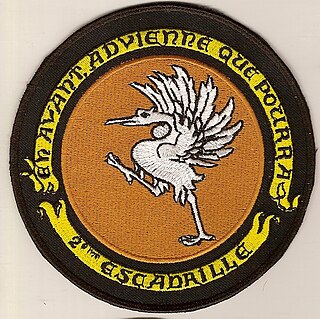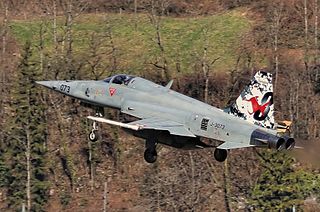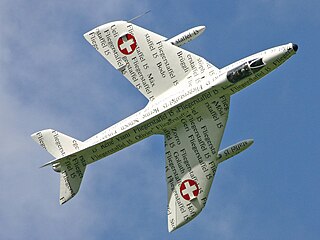
Fliegerstaffel 2 was using Hawker Hunter aircraft for the Swiss Air Force at the time of disbandment. Its pilots origined from French-speaking Switzerland and its home was the military airfield of Turtmann then. As a coat of arms, Fliegerstaffel 2 used a white bird taken from the one of Gruyère District on a red background surrounded by a motto saying "En Avant, Advienne Que Pourra". 2ème Escadrille .
Fliegerstaffel 3 of the Swiss Air Force belonged to the Überwachungsgeschwader, thus professional military pilots were grouped in the unit. Their home base on disbandment was Sion and the aircraft flown were the Mirage III RS. Fliegerstaffel 3 carried the AMIR badge as their coat of arms. This badge shows a falcon head drawn in black lines on white ground, the neck of which is filled with blue color. The beak rises above the round badge, above the head of the falcon is the red number 3. Except for the number 3, the badge is identical to the AMIR badge of Fliegerstaffel 10 and Fliegerstaffel 4.

The Fliegerstaffel 4 of the Swiss Air Force, and belonged to the Überwachungsgeschwader with professional military pilots. Their home base at the dissolution was the Payerne Air Base and the Fliegerstaffel 4 was equipped with Mirage IIIRS. The Fliegerstaffel 4 carried as the coat of arms the AMIR badge. This badge shows on a white ground a falcon head drawn with black lines, the neck of which is filled with blue color. The beak rises above the round badge, above the head of the falcon is the red number 4. Except for the number 4, the badge is identical to the AMIR badge of the Fliegerstaffel 10 and the Fliegerstaffel 3.

Fliegerstaffel 5 was a unit of the Swiss Air Force. It belonged to the Überwachungsgeschwader with professional military pilots. It was equipped with the Hawker Hunter. Its home base was Interlaken Air Base. Fliegerstaffel 5 carried as a coat of arms a black lynx with yellow eyes, which stretched its right paw with claws. From his mouth came red flames, which went into the background. The badge was round and had a white base. Under the lynx was written in black 5éme escadrille. Later, the badge was changed into a shield-shaped coat-of-arms with a stylized lynx head, often mistaken as a dragon head.

The Fliegerstaffel 6 of the Swiss Air Force is a militia squadron equipped with Northrop F-5E and is together with the Fliegerstaffel 18 part of the Fliegergeschwader 14. The home base of the Fliegerstaffel 6 is Payerne Air Base. As coat of arms, the Fliegerstaffel 6 carries since 1940 a marching duck, with a proudly swollen breast carrying a halberd. The "Jusqu'au bout" motto means until the bitter end. Before this badge, it was first a six-pointed star with a witch on her flying broom.

Fliegerstaffel 7 was a Swiss Air Force squadron equipped with Hawker Hunter aircraft until 1994. Their home base at the time was the Meiringen Air Base. As a coat of arms, Fliegerstaffel 7 carried a jumping yellow Trout named "Jaqueline" on a dark blue background. The badge itself was a isosceles triangle with a black border that stood on top.

Fliegerstaffel 8 «Vandalos» is a Swiss Air Force militia squadron, equipped with Northrop F-5E and forms Fliegergeschwader 13 with Fliegerstaffel 11. The home base of the unit is Meiringen Air Base. As coat of arms, the Fliegerstaffel 8 carries as a red sawfish, floating through the lower opening of a black number 8 on a white ground. The sawfish is called Vandalo .
The Fliegerstaffel 9 of the Swiss Air Force was in its end equipped with de Havilland Venom Combat Aircraft. Their home base at the dissolution was the Sion Airport. The Fliegerstaffel 9 carried as coat of arms the side view of a red witch riding on a red broom. On a rectangular dark blue background. The witch and the broom were drawn without curves. Beneath the witch stands a flight of fliers with white writing. In the upper right corner is a white square 9.

Fliegerstaffel 10 was a Swiss Air Force unit consisting of professional military pilots, belonging to the Überwachungsgeschwader. Their home base at the dissolution was the Military Airfield at Buochs, where ist was equipped with Mirage IIIRS. Fliegerstaffel 10 carried as their coat of arms the AMIR badge. This badge shows on a white ground a falcon head drawn with black lines, the neck of which is filled with blue color. The beak rises above the round badge, above the head of the falcon is a number 10 in red. Except for the number 10, the badge is identical to the AMIR badge of the Fliegerstaffel 3 and the Fliegerstaffel 4.
Fliegerstaffel 11 (Tigers) of the Swiss Air Force is a Berufsfliegerkorps squadron equipped with F/A-18 combat jets and, together with Fliegerstaffel 8, is part of Fliegergeschwader 13. The home base of Fliegerstaffel 11 is Meiringen Air Base. Fliegerstaffel 11 is a full member of the NATO Tiger Association and carries a coat of arms depicting a Tiger head on a black background and the wordmark Staffel 11 below the tiger head as its crest.

Zielflugstaffel 12, former known as Fliegerstaffel 12 of the Swiss Air Force is a militia squadron equipped with Northrop F-5E and Pilatus PC-9 and part of the Flugplatzkommando 7. The home base of the unit is Militärflugplatz Emmen. As coat of arms, the Zielflugstaffel carries a badge with a yellow and black target pattern, a bullseye and the writing “ Zfl St 12”.

Fliegerstaffel 13 of the Swiss Air Force was equipped with Northrop F-5 flown by militia pilots when disbanded in 2000. Their home base at the dissolution was Payerne Air Base. Fliegerstaffel 13 wore a shield-shaped insignia with a blue outer edge, showing an eagle with wings spread out and spread claws ready to capture its prey, against a white background and the red number 13 in front of the upper wing. The old emblem was round with orange background and black border. It showed the stylized side view of a black wasp whose head looks in the direction of the viewer, over its head was the number 13.

The late Fliegerstaffel 15 of the Swiss Air Force was active until 1994 and equipped with Hawker Hunter aircraft. The home base of their last service was the airfield at St. Stephan. The Fliegerstaffel 15 carried as their coat of arms a paper aircraft on a blue ground with a red "15". The old badge of the FlSt15 was a black bird of prey with white background and two red circles.

The Fliegerstaffel 16 of the Swiss Air Force was last equipped with Northrop F-5 F aircraft. Their home base was Sion Airport. The Fliegerstaffel 16 had a shield-shaped coat of arms showing the side view of a black dragon with a red eye, red claws, and a red firebeam in front of the white digit 16 and a dark blue background. The old badge was the same, but in round design.

Fliegerstaffel 20 was a Swiss Air Force squadron equipped with Hawker Hunter aircraft. Their home base at the dissolution was the military airfield at Mollis. The squadron carried as its coat of arms a black Bison on a yellow background. The writing “Fl St 20” below the Bison appeared during in the squadron's history.

Fliegerstaffel 21 was a Swiss Air Force squadron equipped with Hawker Hunter aircraft at the dissolution in 1994. Their home base was at the Raron Military Airfield. As a coat of arms, Fliegerstaffel 21 carried a white beaver, firing two guns while riding a red shark. On the shark is the black digit 21.

The Fliegerstaffel 24 fighter squadron 24 of the Swiss Air Force was a former standalone squadron, which is now the ECM (German:EKF) part of the Zielflugstaffel 12. It is a militia squadron and belongs to the airfield command 7. Its home base is the Militärflugplatz Emmen. The Fliegerstaffel 24 carries as coat of arms an eagle in front of a light blue background, holding a lightning bolt in the right claw, in the background is a red-orange number 24 and above the coat of arms is a red-orange area with the black writing "Fliegerstaffel".



























